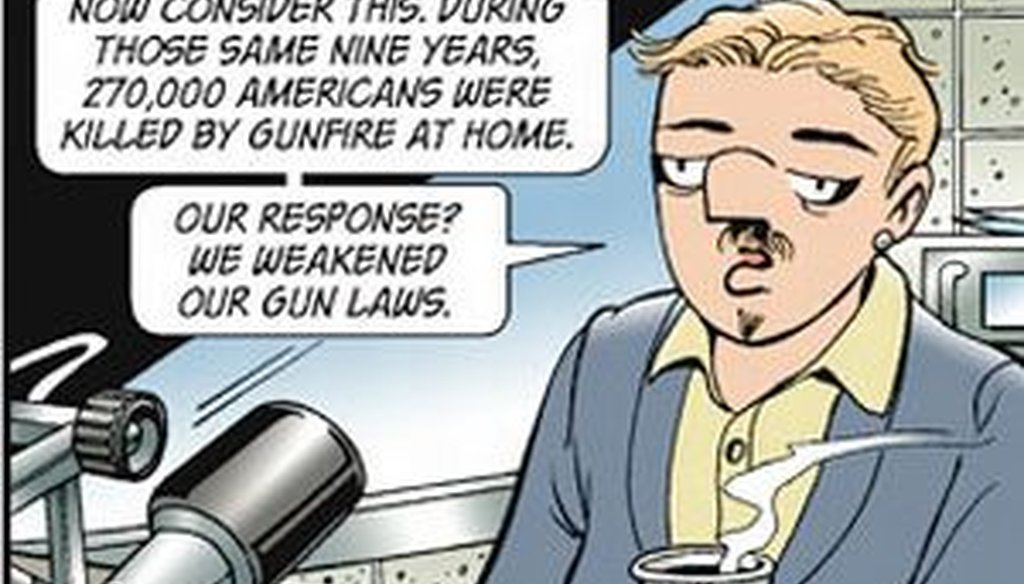

Our only agenda is to publish the truth so you can be an informed participant in democracy.
We need your help.


In a Sunday strip, Doonesbury character Mark Slackmeyer muses about the nation's divergent responses to deaths by terrorism and gun violence. We check his numbers.
In the Sunday, Feb. 13, 2011, installment of the comic strip Doonesbury, Mark Slackmeyer -- a longtime character in the strip who is a liberal radio host -- makes a point about gun violence.
"What are we like as a people?" Slackmeyer muses to himself in his studio. "Nine years, ago we were attacked -- 3,000 people died. In response, we started two long, bloody wars and built a vast homeland-security apparatus -- all at a cost of trillions! Now consider this. During those same nine years, 270,000 Americans were killed by gunfire at home. Our response? We weakened our gun laws."
At that point, a whirring sound comes from off-panel. In the final panel, we see that his guest is a space alien, who says, "Fail. Cannot Comprehend." To which Slackmeyer cracks, "Well, you may be a little jet-lagged."
A reader asked us to fact-check it. So we’ll look at whether since Sept. 11, 2001, "270,000 Americans were killed by gunfire at home."
We began by contacting Garry Trudeau, the cartoonist who has drawn Doonesbury for more than four decades. He got back immediately with a summary of his methodology.
"The final figure lacks precision, because it's extrapolated," Trudeau wrote us, noting, correctly, that the most recent data for gun deaths from the Centers for Disease Control and Prevention is from 2007.
"What I had were six years -- 2002-2007 -- of a remarkably stable number, around 30,000" gun deaths per year, Trudeau wrote. "So in my judgment, multiplying 30,000 times nine yielded a figure reasonable and accurate enough for rhetorical purposes without using hyperbole. If anything, it may be slightly on the low side."
We found that Trudeau was basically right. We went to the same CDC database he used -- the Web-based Injury Statistics Query and Reporting System (or WISQARS for short) -- and got virtually identical numbers. Our number came out slightly higher -- 281,757 -- because we not only extrapolated out through the end of 2010 in our calculations but also included the final three months of 2001.
We should note the details of Trudeau’s definition of gun deaths, which is also the definition we would have used if we’d been starting from scratch. It includes the following categories:
• Suicides: 102,002 between 2002 and 2007
• Homicides: 73,148 between 2002 and 2007
• Accidental: 4,185 between 2002 and 2007
• Legal shootings: 1,999 between 2002 and 2007
• Undetermined: 1,427 between 2002 and 2007
-- Total: 182,761 between 2002 and 2007
So on the numbers, Trudeau’s methodology was accurate.
The only thing that threw us was how the strip had described where the deaths occurred -- "270,000 Americans were killed by gunfire at home" (our emphasis).
Initially, we took that to mean that 270,000 Americans were literally killed in or near their homes. And we knew that couldn’t be right, because the number both we and Trudeau calculated included all gunfire deaths, wherever they had occurred.
When we asked criminologists for guidance on what percentage of gun deaths occur at home, they said the statistics on that question are scattershot. James Alan Fox, a criminologist at Northeastern University, provided data on Chicago homicides from an amicus brief he wrote for a Supreme Court case. Since 1965, the ratio of outside-the-home handgun homicides in Chicago to those occurring at home has tended to bounce around from about two-to-one in the 1970s to about five-to-one in the 1990s.
So if one interprets "at home" to mean in or near someone’s home, the numbers Trudeau calculated wouldn’t be correct.
When we raised this point with Trudeau, he said that wasn’t what he meant: "I didn't say ‘in the home,’ I said ‘at home’ as opposed to abroad, where the wars are. Failure to communicate clearly, I guess. Rats."
Reading through it again, we think Trudeau’s explanation sounds reasonable. But we decided to mark Trudeau down slightly because we think it’s also reasonable for people to make the same initial assumption we did, that "at home" means in or near one’s home. So we’ll rate the comment Mostly True.
Doonesbury, comic strip, Feb. 13, 2011
Centers for Disease Control and Prevention, main search page for Web-based Injury Statistics Query and Reporting System (WISQARS), accessed Feb. 14, 2011
Professors of criminal justice amicus brief in McDonald v. City of Chicago (U.S. Supreme Court), Jan. 6, 2010
E-mail interview with James Alan Fox, criminologist at Northeastern University, Feb. 14, 2011
E-mail interview with Kimberly A. Vogt, sociologist at the University of Wisconsin-La Crosse, Feb. 14, 2011
E-mail interview with Garry Trudeau, creator and cartoonist of Doonesbury, Feb. 14, 2011
In a world of wild talk and fake news, help us stand up for the facts.
